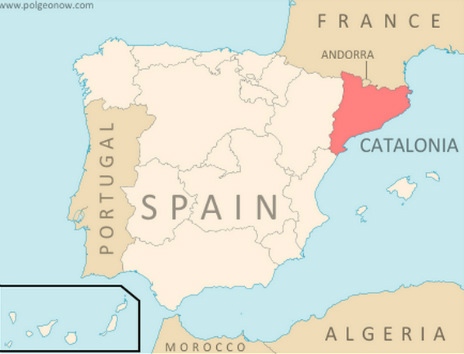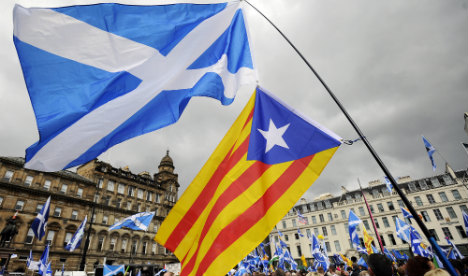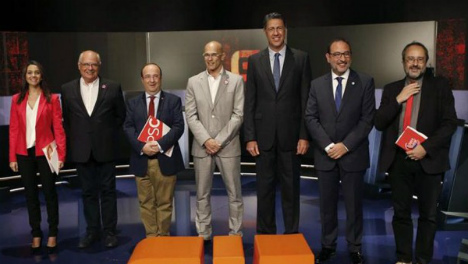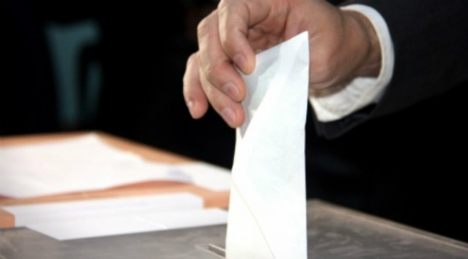What is Catalonia?
The roughly triangular northeastern corner of Spain wedged between the Pyrenees and the Mediterranean and bordering France and Andorra, Catalonia is home to 7.5 million people. With a GDP of €200 billion it is the richest of Spain's 17 semi-autonomous regions and has a language, culture and history distinct from the rest of Spain.

Map: Polgeonow.com
Why all the fuss about a regional election?
What should be a regional election for Catalonia’s 135 seat parliament has been commandeered to be a plebiscite on the sole issue of independence that will determine whether Catalonia will go down the path towards independence or not.
Why do Catalans want independence?
Although there has been a historical struggle for independence, the separatist movement has gained momentum since the start of the economic crisis when many in wealthy Catalonia felt they unfairly subsidized poorer regions of Spain and contributed more than they got in return. That coupled with a refusal by Madrid to accept a new economic charter and what many saw general malaise with the central governing institutions has seen the movement grow from strength to strength.
Why not just hold a Scottish style referendum?

Photo: Andy Buchanan / AFP
The pro-independence camp have tried unsuccessfully to have a legal referendum on whether Catalonia should be an independent state after their efforts were blocked by Madrid and declared illegal by Spain’s Constitutional Court.
Instead a 'symbolic referendum' was held last November, in which more than 80 percent of participants voted in favour.
So do most people want independence?
According to recent polls, Catalans overwhelmingly believe that they should have the right to hold a vote on independence although less than fifty per cent said they would actually vote to secede from Spain.
Who stands for what?

Photo: TVE
The two main pro-independence parties – CDC on the centre right and left wing ERC – have teamed up to form a join list Junts pel Si (Together for Yes) with current president Artur Mas seeking reelection. They say that if they win the most votes they will immediately start a process negotiating a separation with Madrid and proclaim independence within 18 months.
Another pro-independence party, the radical left wing CUP is likely to lend them support to gain an absolute majority if needed.
The conservative PP and Catalan Socialist party are against independence, so too is Ciutadans. The Podemos backed platform Catalunya sí que es Pot (CSQEP) – Catalonia yes we can– is putting the independence issue to one side preferring to focus on social issues.
READ Catalonia elections:The key players
What do the polls say about this election?
Más del 60% de los catalanes quieren permanecer en España http://t.co/oGH2OQtMSC El independentismo roza el 50% de los votos
— EL PAÍS (@el_pais) September 20, 2015
According to a host of different polls published in the last three weeks, the two separatist groupings – Junts pel Sí and CUP – are set to win the election and possibly even achieve an absolute majority.
Ciutadans – led by Inés Arrimadas – is expected to become the main opposition party in the Catalan Parliament, closely followed by the left-wing Catalunya Sí que es Pot.
The traditional parties of the PP, PSOE and the regional christian democrat party Unió ( which broke away from Artur Mas’s CDC earlier this year) are expected to win less seats than at the previous Catalan election in 2012.
What about turnout?
It all comes down to turnout. Those clamouring for independence tend to exercise their right to vote while those in favour of the status quo are more likely to stay at home.
This is likely to be one of the best turnouts for decades with an estimates running at a high 70 percent turnout.
How does the election work?

Photo: Cataloniavotes.eu
The 135 members of the Catalan parliament are elected in four districts using proportional representation: Barcelona (85), Tarragona (18), Girona (17) and Lleida (15). A list must take at least three percent of the vote in each district in order to win seats.
68 seats are needed for a majority. But the system means that is possible to achieve with just 45 per cent of the vote.
There are around 5.5 million voters on the electoral role and they can cast their ballot at one of the 2,697 polling stations open on election day.
What next?
If the independence parties clinch a majority then they say that “it means that the Catalan people have given a clear, democratic and unmistakable mandate for its Parliament to advance towards independence”.
At that point, the Parliament and the Government of Catalonia will “start negotiations with Spain and the international community to achieve the best way to implement this mandate.”
Artur Mas believes he will be in a strong position to negotiate with Madrid and says he wants to broker an “amicable separation” and he insists that Catalonia will be able to find a way to stay within the Eurozone.
The EU has said seceding from Madrid would mean automatic expulsion for Catalonia from the bloc and Catalonia has so far been unable to garner much support from member states who fear it may steer a course for other separatist movements.
Madrid won’t make it easy at all. The Spanish constitution expressly forbids any move towards dissolving the unity of Spain and the current conservative government of Mariano Rajoy is dead set against any constitutional reform.
But with general elections just around the corner, who knows what the future holds?


 Please whitelist us to continue reading.
Please whitelist us to continue reading.
Member comments